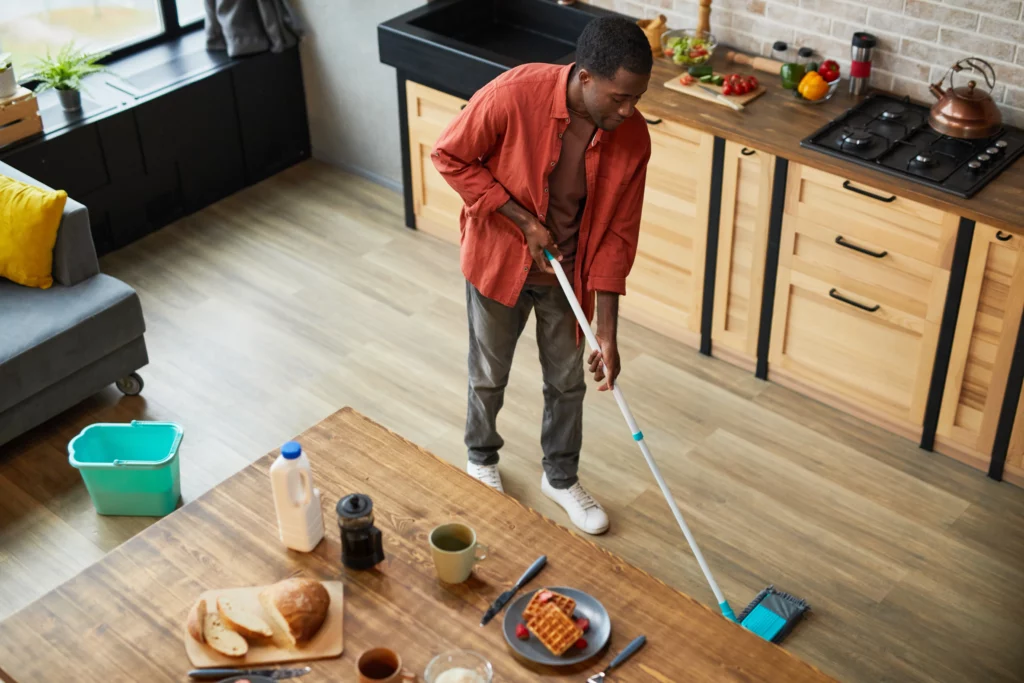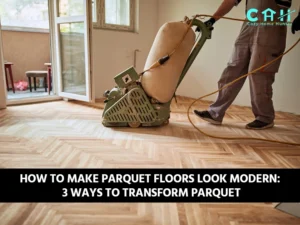Unfinished wood flooring has its very own charm. It adds a natural aesthetic to any place like no other flooring option. As it doesn’t have a protective layer of wax or any other finishing, you need to be very diligent about cleaning the unfinished wood floor.
To clean unfinished wood floors, start by removing all the dust and debris. If possible, clear out the furniture or any other objects. Prepare a cleaning solution that is safe for unfinished wood floors. Dampen a microfiber cloth or mop using the solution and start mopping along the grain of the wood.
Regularly cleaning your wood floor will keep it sparkly for decades. Let’s get into more details on how to clean unfinished wood floors without damaging them in four easy steps.
Table of Contents
How to Tell If Your Wood Floor is Unfinished?

Simply put, unfinished wood flooring is the raw material. The wood is turned into planks to create unfinished or untreated hardwood floors. In contrast, a finished hardwood flooring has a protective layer or seal of polyurethane, hard-wax oil, oil sealer, or even aluminum oxide.
The unfinished wood flooring does not have this protective layer, so it is highly vulnerable to moisture. There are various ways to tell whether your hardwood is appropriately sealed or not –
- Place a few drops of water on your wooden floor and wait a few minutes. If the water beads up, you have a protective layer. If not, you have unsealed hardwood floors.
- Take some fine steel wool and rub an inconspicuous area of your floor. The floor is sealed with wax if you find a gray film on the steel wool.
- Contact the installer or a professional to help you find out if your hardwood is sealed and the type of seal you have.
How to Clean Unfinished Wood Floor?

Step 1: Sweep or vacuum the floor thoroughly
Dirt and grime build-up can be a major hurdle to cleaning wood floors. Keeping dirt and debris off the floor is key. Dust particles act like sandpaper when you step on them and scratch the surface. They can also get into the wood textures and damage them. It is recommended to sweep or vacuum high-traffic areas daily. You can also run your Roomba in places like the kitchen, dining area, family living, etc. You can run the vacuum or sweep once or twice a week in fewer traffic areas.
After the daily sweep using a broom, you can use a dry mop or dust mop to pick up any remaining dirt if you are not going to follow up with mopping. You can also run dry (microfiber cloths) to clean up the fine dust that the broom hasn’t picked up. Make sure you use a soft-bristled broom and, of course, move with the grain when cleaning. Use the hard floor setting on your vacuum to avoid scratching the wood with the brush roll.
Step 2: Prepare vinegar solution
As unsealed wood is fairly delicate, cleaners with harsh chemicals are not recommended. Avoid using any detergent or soap that can damage the wood surface. Many professional cleaners prefer homemade vinegar-based cleaners for cleaning unsealed wood. Vinegar’s slightly acidic pH disinfects and cuts through grimes and oil. It also leaves a streak-free shiny finish.
Step 3: Prepare the area
Before moving on to mopping, remove any portable object from the floor that will make it challenging for you to clean the floor. Remember that the more edges and corners you have around the room, the higher the chances of debris getting stuck. Remove the furniture if possible. Lastly, block the entrances around the house to stop children or pets from stepping on the damp floor.
Step 4: Use a damp mop to clean the floor
For the best mopping result on your wood floor, keep five key things in mind –
- Use a damp mop, not wet
- Use a flat microfiber mop or microfiber twist mop
- Mop in an “S” pattern
- Dry the floor quickly by either using a ceiling fan or microfiber cloth
- Mop along the grain of the wood
Prepare your mopping solution and soak the mop head in the bucket for a few minutes to soften. Put the mop in the wringer and twist until almost dry. If you are using a flat-head mop, slide it against the dryer at least 3 to 4 times. Start mopping from a corner using an “S” shaped pattern and sweep your way out of the room.
When mopping a large area, divide the floor into sections for the best result. To be extra diligent, you can take a microfiber cloth and do a quick wipe down, so no water is left behind. You can also turn on the ceiling fan to dry the floors. Change the water once it becomes dirty. A quick rule of thumb is to change the water once you can’t see the bottom of the bucket. Rinse and re-dampen the mop often to avoid streaks.
You should mop high-traffic areas at least once or twice a week. For less-trafficked floors, you can get away with mopping once per month or once a season. Avoid mopping against the grain for the best results.
Can You Mop Unfinished Wood Floor?

You can mop an unfinished wood floor using a damp microfiber mop and a natural cleaner. Make sure to dry the floor completely afterward to prevent any moisture-caused damage. You can use a dry microfiber cloth for a quick wipe down. Clean a single section at a time and dry it before moving on to the next. Never use wet mops to clean unfinished wood as it is incredibly vulnerable to moisture and might cause warping. It is also recommended to mop unfinished wood floors less often.
How to Protect Unfinished Wood Floor

Sweep and vacuum regularly
The untreated wood floor might get damaged from deep cleaning or mopping too often, so keep dust and debris away from it as much as possible by cleaning without getting it wet. It is recommended to sweep and vacuum high-traffic areas daily. You can clean less trafficked areas once or twice a week. You can also use a static dust mop to pick up specks of dust and other particles off the floor.
Use furniture pads
The bottom of your furniture can scratch up the wood and damage them. Use a furniture pad to limit damage from movements of the furniture.
Use doormats
Doormats absorb dust and dirt and keep the floors clean for longer. They also trap soil from shoes which can scratch up the wooden surface. Use doormats in all entrances to the house and in high-traffic areas. You can also place rugs and runners in areas prone to spills and water drops, such as the kitchen or in front of the bathrooms.
Clean up spills immediately
Never leave wet or sticky spills on any wooden surfaces. Wipe up spills immediately using a damp cloth and dry the area.
Spot clean wherever possible
Resort to spot cleaning instead of deep cleaning to protect your wooden floor. It helps delay the cleaning day and keeps your floors cleaner for longer without the need to mop them.
How to Make Unfinished Wood Floor Shine?
Usually, the seal of hardwood gives it the shine. However, you can treat your unfinished wood floor with oil or wax to make it shiny. Also, it removes the residual layer of dirt and grime from the floor.
Treat it with oil
Natural oils such as linseed or jojoba are great options to add a natural shine to the floor and loosen up grime and dirt. Use a soft rug or microfiber cloth to apply the oil on the floor and let it sit for 15 minutes. Buff the oil using a dry mop and remove any remaining dirt and grime.
Apply wax
Choose a petroleum-based, waterless wax and apply it using a soft rug. Let the wax dry on the floor for half an hour, and then buff it using a clean cloth. You can also use a buffing machine to save time.
How to Deep Clean Unfinished Wood Floor?

Regardless of how often you clean your wood flooring, you will need to do a deep cleaning every once in a while. It’s best to use waterless solutions for deep cleaning the unfinished wood floor. The most effective ways to deep clean unfinished wood floor are –
Using mineral spirit
Mineral spirit is a petroleum-derived liquid that is highly potent at removing hard stains from hardwood. Sprinkle a small amount of the solution on the floor and gently rub it using a microfiber cloth. Make sure to remove any excess liquid from the floor.
Although it is powerful in cleaning tough stains, the mineral spirit is highly toxic. It vaporizes at room temperature, which you can inhale when working with them. Wear a mask for protection and ensure enough ventilation in the room while using mineral spirit.
Using trisodium phosphate
Trisodium phosphate is a crystallized powder that you can find at any local hardware or home improvement store. To clean the wood floor using it, sprinkle a small amount on the floor and scrub gently using a soft-bristled brush.
When the floor is clean, remove excess product using warm water and dry the area using a clean towel or microfiber cloth.
Using sandpaper
If your floor has a stubborn stain that the previous two methods failed to tackle, you can sand the area with fine sandpaper. However, do not apply excess pressure when sanding the wood. Check often to see if the stain is removed. Avoid excessive sanding to prevent splintering and damage to the wood. Use a soft-bristled angle broom or vacuum cleaner to clean up the area.
Knowing how to maintain and clean unsealed wood floors is crucial in preserving their perfect condition and making them last for decades. Do you have any questions about cleaning the unfinished wood floor? Comment below and let us know!







3 Responses
Thanks for also talking about how the to test if the wood floor has protective coating or not. That will surely be important to consider when getting wood floor cleaning and buffing services in the future. I will surely need that before getting new furniture in my living room so that the flooring will finally be able to get some maintenance after a long time.